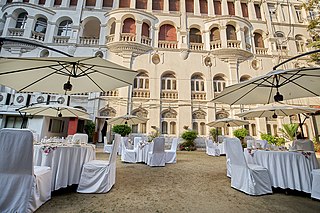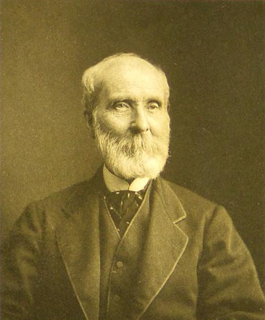Maharaja Nandakumar, was an Indian tax collector for various regions in what is modern-day West Bengal. Nanda Kumar was born at Bhadrapur, which is now in Birbhum. He was the first Indian to be executed by hanging. Nandakumar was appointed by the East India Company to be the dewan for Burdwan, Nadia and Hoogly in 1764, following the removal of Warren Hastings from the post.

Gaganendranath Tagore was an Indian painter and cartoonist of the Bengal school. Along with his brother Abanindranath Tagore, he was counted as one of the earliest modern artists in India.

The Bengali Brahmins are Hindu Brahmins who traditionally reside in the Bengal region of the Indian subcontinent, currently comprising the Indian state of West Bengal and the country of Bangladesh. When the British left India in 1947, carving out separate nations, many Brahmins, whose original homes were in the newly created Islamic Republic of Pakistan, migrated en masse to be within the borders of the newly defined Republic of India, and continued to migrate for several decades thereafter to escape Islamist persecution.

Romesh Chunder Dutt was an Indian civil servant, economic historian, writer and translator of Ramayana and Mahabharata. Dutt is considered a national leader of the pre-Gandhian era, and was a contemporary of Dadabhai Naoroji and Justice Ranade.
Harendra Narayan Das, better known as Haren Das, was a highly respected artist in India who worked almost exclusively in printmaking mediums. His work included engravings, linocuts, etchings, and lithographs, though he is most remembered for the technical skill of his woodcuts and wood engravings.

Margaret Sarah Carpenter was an English painter. Noted in her time, she mostly painted portraits in the manner of Sir Thomas Lawrence. She was a close friend of Richard Parkes Bonington.

James Atkinson was a surgeon, artist and Persian scholar — "a Renaissance man among Anglo-Indians"

The Bengal Club is a social and business club in Kolkata, India. Founded in 1827, the club is the oldest social club in India. When Kolkata was the capital of British India, the club was considered to be the "unofficial headquarters of the Raj". The club is nowadays known for its old-world ambience and patronage among contemporary social and corporate elites, and is among a small number of Indian clubs featured in the elite list of the "Platinum Clubs of the World".
Harriet Gouldsmith was an English landscape painter and etcher.

John Henry Frederick Bacon was a British painter and illustrator of genre works, history and bible scenes, and portraits.

Thomas Bridgford RHA, Royal Hibernian Academician, was a British artist, in London and Manchester, England. Bridgford was born 6 April 1812. He moved with his family to Ireland, in 1817. In 1827 he first exhibited work at the Royal Hibernian Academy aged fifteen. He went to London in 1834, to work as a portrait painter, returning to Dublin in 1844. Whilst in London he regularly exhibited at The Royal Academy between 1834 and 1844.
The Philatelic Society of India (PSI) was formed in 1897 by a group of, mainly, expatriate Englishmen resident in the country as the first all-India philatelic society. During its first fifty years the society included most of the important Anglo-Indian philatelists and had a particularly strong publications record with two award-winning books. The society meets every first and third Saturday at the Mumbai G.P.O., convened by Dhirubhai Mehta, President, and D.M. Pittie, Hon. Secretary.

Joseph Austin Benwell (1816–1886) was an English artist, engraver and illustrator. He was primarily an artist in the 'orientalist' style. Many of his paintings and engravings were based on his travels in the Near and Middle East, China and India, often featuring camel caravans, Arab scenes and depictions of Indian life.

Henry Tanworth Wells was an English miniature and portrait painter. He was a member of the Pre-Raphaelite circle though he painted in the academic style.

Daniel Albert Wehrschmidt (1861-1932) was an American artist from Ohio who made a career for himself in England as a portrait painter, lithographer and engraver.

George Parbury (1807–1881) was a British publisher with a special interest in India, a freemason in India and London, Master of Merchant Taylors livery company, Justice of the Peace for two counties and Deputy Lieutenant of the Tower Hamlets.

James Rattray was a soldier and artist, born in Daventry, Northamptonshire, England, who died at Dorundah, in the Ranchi Division, Nagpore, India. At the time of making his notable sketches he was a 2nd Lieutenant in the 2nd Grenadiers, Bengal Army, serving in Afghanistan.

Colesworthey Grant was an English artist, writer and pioneer activist against cruelty to animals in India. Teaching himself art and sketching, he produced numerous portraits of many early East India Company servants of influence in Calcutta which were published in the local periodicals of the time. He later became a professor of drawing. He founded the Calcutta Society for the Prevention of Cruelty to Animals in 1861 after seeing the sorry conditions especially of draught animals on the streets of Calcutta.

Edward Hare was a British surgeon and former Director-General of Hospitals in Bengal, India. Hare is best known for his medical work in using quinine for treatment of malaria fevers. He was also a vegetarianism activist.

















